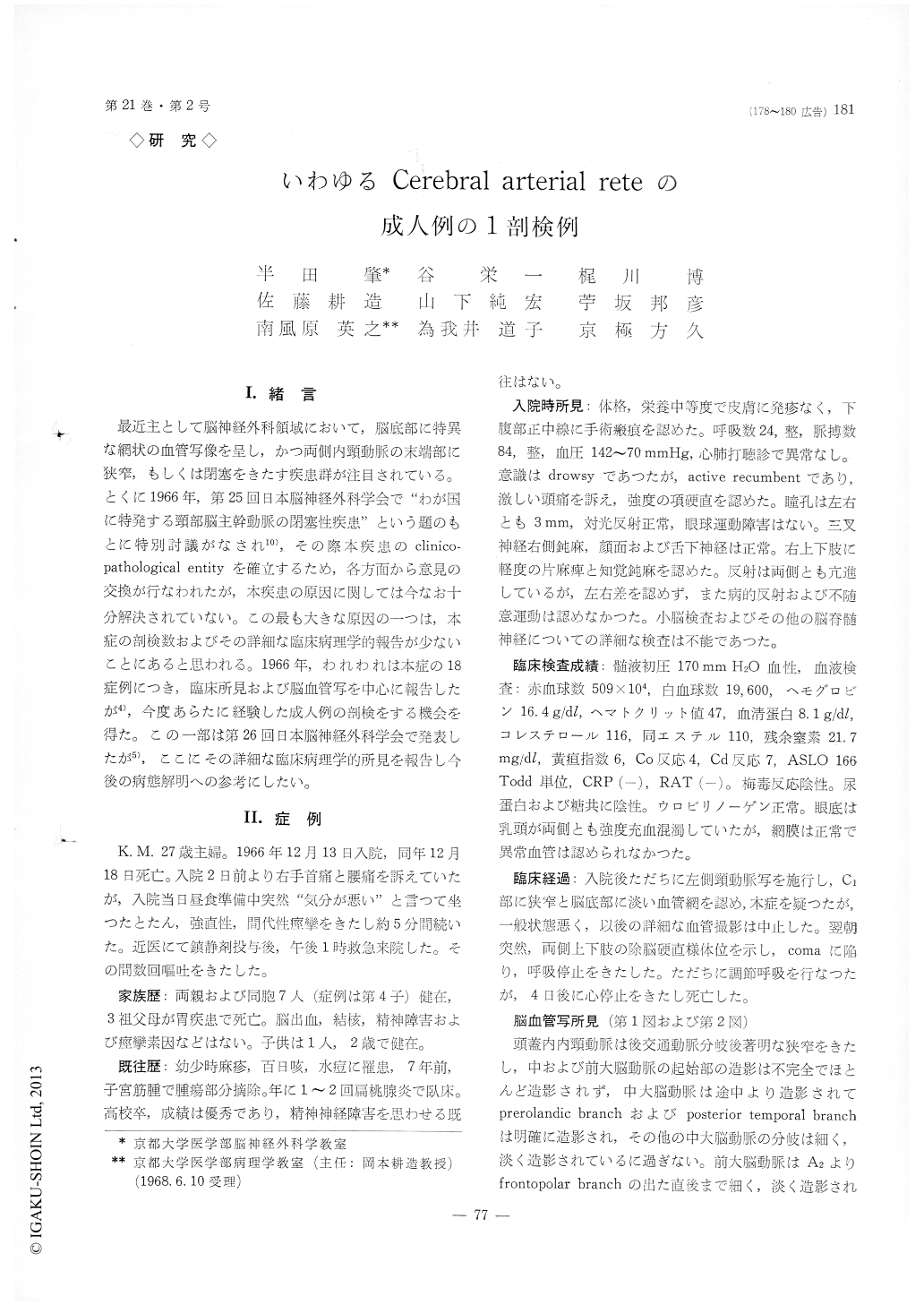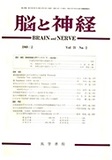Japanese
English
- 有料閲覧
- Abstract 文献概要
- 1ページ目 Look Inside
I.緒言
最近主として脳神経外科領域において,脳底部に特異な網状の血管写像を呈し,かつ両側内頸動脈の末端部に狭窄,もしくは閉塞をきたす疾患群が注目されている。とくに1966年,第25回日本脳神経外科学会で"わが国に特発する頸部脳主幹動脈の閉塞性疾患"という題のもとに特別討議がなされ10),その際本疾患のcllnico—pathological entltyを確立するため,各方面から意見の交換が行なわれたが,木疾患の原因に関しては今なお十分解決されていない。この最も大きな原因の一つは,本症の剖検数およびその詳細な臨床病理学的報告が少ないことにあると思われる。1966年,われわれは本症の18症例につき,臨床所見および脳血管写を中心に報告したが4),今度あらたに経験した成人例の剖検をする機会を得た。この一部は第26回日本脳神経外科学会で発表したが5),ここにその詳細な臨床病理学的所見を報告し今後の病態解明への参考にしたい。
The cerebral arterial rete, characterized by marked stenosis or occlusion of main arteries in the circle of Willis and vascular abnormality composed mainly of arteries and arterioles in the diencephalon, has been discussed recently in this country.
A 27-year-old female was admitted with the chief complaint of sudden onset of headache and vomiting followed by general convulsion. Physical exami-nation disclosed bloody cerebrospinal fluid and right-sided weakness.
Left carotid angiography showed an obstruction of the internal carotid artery before the origin of the anterior and middle cerebral arteries. The most dis-tal branch visualized was the posterior cerebral artery. The origin of the anterior and middle cere-bral arteries was not visualized, but the anterior cerebral (A2) as well as the middle cerebral (M2) were partially reformed. The posterior communicat-ing as well as the posterior cerebral were consider-ably dilated and well visualized in their branches. The pericallosal was mainly supplied from the branches of the posterior cerebral. The communi-cation was evident between the ophthalmic branches with the frontopolar branches.
The vascular abnormality was observed in the vicinity of the carotid occlusion, possibly arising from the perforators of the anterior and the middle cer-ebrals.
In histological examination, intimal proliferation was evident in both sides, such as internal carotid, anterior cerebral, middle cerebral, and perforators in the extracerebral as well as partially in the intra-cerebral portions, and was most marked in the sites of branching of the main arteries. The intimal thick-enings found consited of collagen fibers and some fine elastic fibrils.
There was no evidence of inflammation and athero-sclerosis. A newly formed elastic lamina was usually most noticeable at the edge of the thickening. The new lamina appeared in places, and was pale and lacy. The lamina thus formed fused to the original lumina at the edges of the intimal thickenings, and gave an appearance of splitting of the original lamina. The duplication, however, was formed not by splitting but by the formation of new elastic fibrils beneath the endothelium.
The intimal thickening in this autopsy case was essentially similar in histological feature to the in-timal pads (Verzweigungspolster).
Some of the perforator branches in the cerebral tissue revealed an abnormal proliferation of elastic fibrils without intimal proliferation. Others were marked dilated and appeared in part to form a shunt-ing between the dilated an the non-dilated vessels.
Similar vascular changes were observed in the pia and its underlying cortex and white matter. It seemed to be reasonable to assume, therefore, that the histological appearance of some perforators in the intracerebral portion was similar in changes to that in the pia and its neighboring cortical tissue.
On the basis of the histological examination, it seems to be reasonablly assumed that the intimal pads formed in the fetal life proliferate abnormally to extend from the sites of branching of the main arteries to the non-branching portions.
Some vascular changes of the perforators in the intracerebral portion are possibly due to the same mechanism. On the other hand, others axe due to the formation of collaterals.

Copyright © 1969, Igaku-Shoin Ltd. All rights reserved.


